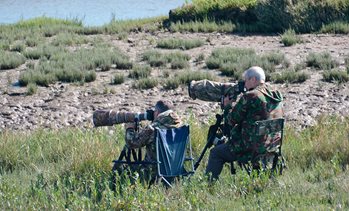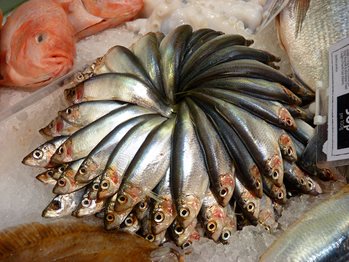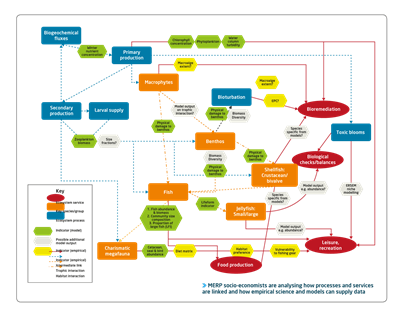 Natural capital is the stocks of natural assets, including geology, soil, air, and all living things, it is the source of a wide range of ecosystem ‘goods and services’ which enable humans to live and exploit the natural world. These goods and services include the air we breathe, the climates and weather we enjoy, or threaten us, food resources, minerals, energy and transport. Some of these can be valued in financial terms, while others such as mental wellbeing, enjoyment and health, though equally important may be less tangible. As human populations grow in size, coastal communities increase and the pressures on the seas that surround our coast spread: the shallow seas that encircle us are busy places with often competing demands on them. Understanding how the marine environment functions to maintain natural capital to provide goods and services, and how we may be altering it directly by over exploitation or indirectly through such phenomena as climate change, and how we balance our varied demands upon marine natural capital is essential for a sustainable future for the seas and ourselves. MERP has brought to bear a vast range of skills and experience from empirical scientists to modellers to socio-economists with the aim of understanding how we can maximise the benefits we get form our seas through trade-offs between economic, ecological and cultural activities and services while maintaining clean, safe and healthy seas, and the living natural capital they contain.
Natural capital is the stocks of natural assets, including geology, soil, air, and all living things, it is the source of a wide range of ecosystem ‘goods and services’ which enable humans to live and exploit the natural world. These goods and services include the air we breathe, the climates and weather we enjoy, or threaten us, food resources, minerals, energy and transport. Some of these can be valued in financial terms, while others such as mental wellbeing, enjoyment and health, though equally important may be less tangible. As human populations grow in size, coastal communities increase and the pressures on the seas that surround our coast spread: the shallow seas that encircle us are busy places with often competing demands on them. Understanding how the marine environment functions to maintain natural capital to provide goods and services, and how we may be altering it directly by over exploitation or indirectly through such phenomena as climate change, and how we balance our varied demands upon marine natural capital is essential for a sustainable future for the seas and ourselves. MERP has brought to bear a vast range of skills and experience from empirical scientists to modellers to socio-economists with the aim of understanding how we can maximise the benefits we get form our seas through trade-offs between economic, ecological and cultural activities and services while maintaining clean, safe and healthy seas, and the living natural capital they contain.
Valuing ecosystem services
MERP has been working on the question of ecosystem service valuation including building a model of the elasticities of UK annual average first-sale market price of fish. This predicts the rate of change in the price of coarse functional groups of fish and shellfish. It takes into consideration the rate of change in landed quantities of this and other groups, as well as various independent indicators of supply and demand, including imports and exports and their prices, the supply of aquaculture products and consumption rates.
Non-monetary valuation
Non-monetary valuation is concerned with those aspects of ecosystem services, such as water quality and landscape value that are difficult to quantify in monetary terms. These are being analysed through interview and questionnaire techniques. A series of video interviews has been completed inviting stakeholders to express opinions and answer structured questions. These have been edited down into a fascinating and engaging 45 minute film, summarising the range of responses. The film is now forming the basis of a further survey which asks respondents to align their own views with those in the film. This will provide a unique insight into how non-monetary ecosystem services are valued by a cross-section of society, and will prove invaluable in informing how management decisions are made in future.
Kelp, coastal connectivity and carbon
.jpg?width=350&height=234) There is growing interest in “source to sink” carbon dynamics in coastal systems and the relative usefulness of MPAs as carbon stores. MERP scientists collected a dataset of 87 variables and how they vary over a seasonal cycle; the aim was to measure how much of a trophic subsidy kelp beds provided to benthic systems, and how this contributed to carbon burial around the coast of the UK. This study builds upon previous work that shows how important kelp can be: around 50% of Scotland’s carbon dioxide emissions may be offset by addition of carbon to long-term stores, and that kelp may contribute up to 30% of carbon to these stores. Despite kelp’s importance it has been previously overlooked. This work has also established that connectivity exists between seaweed communities, coastal carbon stores and the food-web and fills an internationally recognised gap in our knowledge of connectivity of donor coastal regions and sinks. Large amounts of data have been collected via MERP research cruises and are still being analysed, but early indications are that at site L4, off Plymouth, during autumn and winter, when seaweed detritus production is at its greatest, the levels of seaweed derived carbon in the diets of sedimentary fauna, many kilometres from source, is elevated. The evidence is of great importance in improving our ability to manage and protect subtidal carbon stores, through managing the seabed. Already this work has attracted the attention of Blue Carbon Initiative of the IUCN and the UN SDG 14 conference which are major international stakeholders in blue carbon conservation initiatives. The scientists hope that the MERP contribution will start an evidence basis to consider blue carbon in a more encompassing way by bringing the policy perspective (which is currently largely focused on wetlands) and the scientific community together to include other habitats that should fall within the blue carbon definition, and lead to their conservation. The relative usefulness of carbon stores will allow comparison with other functions to assess trade-offs that can be included in management plans, locally and nationally. Further work has assessed large-scale differences in biomass along the north-east Atlantic coastline and attributes them to various environmental and biological factors. This will contribute to understanding how the flow of nutrients and functional role of macroalgae within coastal waters of the UK may be expected to change under future climate scenarios.
There is growing interest in “source to sink” carbon dynamics in coastal systems and the relative usefulness of MPAs as carbon stores. MERP scientists collected a dataset of 87 variables and how they vary over a seasonal cycle; the aim was to measure how much of a trophic subsidy kelp beds provided to benthic systems, and how this contributed to carbon burial around the coast of the UK. This study builds upon previous work that shows how important kelp can be: around 50% of Scotland’s carbon dioxide emissions may be offset by addition of carbon to long-term stores, and that kelp may contribute up to 30% of carbon to these stores. Despite kelp’s importance it has been previously overlooked. This work has also established that connectivity exists between seaweed communities, coastal carbon stores and the food-web and fills an internationally recognised gap in our knowledge of connectivity of donor coastal regions and sinks. Large amounts of data have been collected via MERP research cruises and are still being analysed, but early indications are that at site L4, off Plymouth, during autumn and winter, when seaweed detritus production is at its greatest, the levels of seaweed derived carbon in the diets of sedimentary fauna, many kilometres from source, is elevated. The evidence is of great importance in improving our ability to manage and protect subtidal carbon stores, through managing the seabed. Already this work has attracted the attention of Blue Carbon Initiative of the IUCN and the UN SDG 14 conference which are major international stakeholders in blue carbon conservation initiatives. The scientists hope that the MERP contribution will start an evidence basis to consider blue carbon in a more encompassing way by bringing the policy perspective (which is currently largely focused on wetlands) and the scientific community together to include other habitats that should fall within the blue carbon definition, and lead to their conservation. The relative usefulness of carbon stores will allow comparison with other functions to assess trade-offs that can be included in management plans, locally and nationally. Further work has assessed large-scale differences in biomass along the north-east Atlantic coastline and attributes them to various environmental and biological factors. This will contribute to understanding how the flow of nutrients and functional role of macroalgae within coastal waters of the UK may be expected to change under future climate scenarios.
Plugging the gap in seabed maps.
As more demands are placed upon the coastal waters of the UK it is increasingly important to have access to reliable seabed maps which can be used to address marine policy, planning, spatial management and scientific issues. In Europe much of the existing seabed information has been based upon efforts focussed on seabed classification and discrete habitat mapping, often limited in extent, leaving large gaps in our knowledge. Benthic species have differing sediment requirements, thus mapping sediments can be helpful in providing information on mud content and median grain size, enabling the identification of ecologically distinct habitats. Statistical models have been shown to have the ability to predict sediment composition in British waters and the North Sea with a high degree of accuracy. By taking existing data on seabed sediments and combining it with statistically modelled values the missing parts of the sea bed mosaic can be added and help to provide a series of ‘synthetic’ maps of the north western sedimentary environment covering the area from the Bay of Biscay to the Faroes. This approach, developed by MERP scientists has resulted in the most extensive data sets of sediment composition and disturbance regimes that exist over such a large spatial scale. Not only will these maps benefit future research but they also have management applications in being able to predict species distributions and, knowing how sea beds are naturally disturbed, and what the impacts of anthropogenic activities (trawling, for example) might be.
Six-step cost benefit analysis assessment of MSFD PoMs
 The EU Marine Strategy Framework Directive (MSFD) requires that Member States achieve ‘Good Environmental Status’ (GES) by 2020 through Programmes of Measures (PoMs) based on environmental targets and indicators. Before these POMs are initiated, impacts, including cost benefit analysis (CBA), have to be assessed. CBA may not be able to assign a monetary value to all effects of these measures but at least they have to be listed and acknowledged. Carrying out such assessments requires an interdisciplinary approach between natural and social scientists using economic analysis to evaluate outputs from ecological analyses designed to determine the effects of such management measures. Using CBA does have its challenges however, not least being “lack of knowledge on the links between potential measures, improvement of marine ecosystems and corresponding economic and social value”. In order to add to existing guidance on the application of CBAs to marine ecosystems for the MSFD, MERP has contributed to a comparison of existing environmental CBA application from three member States: Finland, UK and Spain. Each case study takes a different approach reflecting local conditions, accessible data and the nature of the descriptors being studied; to make them comparable a sixstep process was followed. This allowed for systematic interrogation of the strengths and challenges of each approach. It found that challenges indeed arise in valuing the physical impacts in economic terms, and made recommendations including: the need to further develop the CBA approach to better integrate the ecosystem services approach with environmental valuation techniques. Cost effective analysis is recommended where measurement of benefits in an environmental approach is difficult, and the potential of applying multi-criteria analysis, perhaps in conjunction with expert elicitation, which brings together scientific consensus, is also suggested. Finally the use of modelling where models and data exist, or where new models can be constructed, is also recommended as a means of providing cost and benefit estimates, and for predicting future ecosystem service provision.
The EU Marine Strategy Framework Directive (MSFD) requires that Member States achieve ‘Good Environmental Status’ (GES) by 2020 through Programmes of Measures (PoMs) based on environmental targets and indicators. Before these POMs are initiated, impacts, including cost benefit analysis (CBA), have to be assessed. CBA may not be able to assign a monetary value to all effects of these measures but at least they have to be listed and acknowledged. Carrying out such assessments requires an interdisciplinary approach between natural and social scientists using economic analysis to evaluate outputs from ecological analyses designed to determine the effects of such management measures. Using CBA does have its challenges however, not least being “lack of knowledge on the links between potential measures, improvement of marine ecosystems and corresponding economic and social value”. In order to add to existing guidance on the application of CBAs to marine ecosystems for the MSFD, MERP has contributed to a comparison of existing environmental CBA application from three member States: Finland, UK and Spain. Each case study takes a different approach reflecting local conditions, accessible data and the nature of the descriptors being studied; to make them comparable a sixstep process was followed. This allowed for systematic interrogation of the strengths and challenges of each approach. It found that challenges indeed arise in valuing the physical impacts in economic terms, and made recommendations including: the need to further develop the CBA approach to better integrate the ecosystem services approach with environmental valuation techniques. Cost effective analysis is recommended where measurement of benefits in an environmental approach is difficult, and the potential of applying multi-criteria analysis, perhaps in conjunction with expert elicitation, which brings together scientific consensus, is also suggested. Finally the use of modelling where models and data exist, or where new models can be constructed, is also recommended as a means of providing cost and benefit estimates, and for predicting future ecosystem service provision.
Valuing biodiversity – useful for management?
 Contemporary threats to marine biodiversity, including unsustainable fishing, pollution and climate change, are likely to cause unpredictable changes in the provision of ecosystem services (ES). ES are the direct and indirect contributions of ecosystems to human well-being. Valuation of biodiversity and ES is now widely recognised as a useful, though sometimes contentious, tool for conservation and management in the terrestrial environment. The ocean, however, is difficult to study, has complex governance issues, and historically biodiversity, conservation and resource management have been separate. If included at all, it has often been specifically the value of target fisheries, for example, with wider less tangible, ES being ignored. This has resulted in valuation lagging behind, its efficacy often unproven. But, in the face of accelerating loss of marine biodiversity, and hence the ES it supports, MERP scientists working with colleagues form the British Antarctic Survey and The Pacific Community propose a new approach following investigations using three test case areas: the tropical Pacific, the Southern Ocean and UK coastal waters. This relates biodiversity and ES with ecosystem structure and functioning to provide a context within which marine conservation and management decisions can reflect the key role played by biodiversity in sustaining ecosystem value. An approach is recommended which: couples hydrological, ecological and fisheries models with economic models and decision support tools; considers trade-offs in decision making; uses a common terminology to increase understanding and bridge the divide between resource management and biodiversity conservation; and embeds ES valuation and biodiversity in management frameworks.
Contemporary threats to marine biodiversity, including unsustainable fishing, pollution and climate change, are likely to cause unpredictable changes in the provision of ecosystem services (ES). ES are the direct and indirect contributions of ecosystems to human well-being. Valuation of biodiversity and ES is now widely recognised as a useful, though sometimes contentious, tool for conservation and management in the terrestrial environment. The ocean, however, is difficult to study, has complex governance issues, and historically biodiversity, conservation and resource management have been separate. If included at all, it has often been specifically the value of target fisheries, for example, with wider less tangible, ES being ignored. This has resulted in valuation lagging behind, its efficacy often unproven. But, in the face of accelerating loss of marine biodiversity, and hence the ES it supports, MERP scientists working with colleagues form the British Antarctic Survey and The Pacific Community propose a new approach following investigations using three test case areas: the tropical Pacific, the Southern Ocean and UK coastal waters. This relates biodiversity and ES with ecosystem structure and functioning to provide a context within which marine conservation and management decisions can reflect the key role played by biodiversity in sustaining ecosystem value. An approach is recommended which: couples hydrological, ecological and fisheries models with economic models and decision support tools; considers trade-offs in decision making; uses a common terminology to increase understanding and bridge the divide between resource management and biodiversity conservation; and embeds ES valuation and biodiversity in management frameworks.
Waste lines
 Waste bioremediation, removing wastes from ecosystems through storage, burial and recycling is a key ecosystem service. The mussel Mytilus edulis as a filter feeder is an important contributor to this service to the point where it is actively used in managing eutrophic waters, around fish farms, for example, where they clean up. Mussels are known to participate in bioremediation of waste (BW) in three ways: by metabolising processes that change harmful waste into less toxic or harmless waste; by sequestering toxic waste and then storing it, although it may become available and harmful again when mussels are consumed by humans and other animals; and thirdly by transporting harmful waste as solid faeces and pseudofaeces to be recycled or buried in the benthic environment. Mussels are able to bioremediate many types of waste, including excess phytoplankton resulting from eutrophication of coastal waters, toxic products of plankton, highly carcinogenic and mutagenic particles from burnt fossil fuels, heavy metals, microplastics, nanoparticles and pharmaceuticals. Thus while it has not been possible to place a financial value on mussels’ BW service, there is no doubt that it is an important contributor and anything that reduces their ability to provide this service is likely to have impacts on water quality and knock-on effects to other ecosystem processes, food supply, recreation and tourism. Changes in pH due to ocean acidification (OA) have been shown to reduce mussel growth and filtration rate, with projections indicating that by 2100 the biomass of M.edulis may be reduced by 50%. In a study that brought together current knowledge of the resultant effect of OA on waste bioremediation MERP scientists conclude that the effects of OA could be a major issue in the future and they call for further empirical research to fully quantify the contribution made by M.edulis and how that may be compromised by negative impacts on filtering capacity brought about by OA.
Waste bioremediation, removing wastes from ecosystems through storage, burial and recycling is a key ecosystem service. The mussel Mytilus edulis as a filter feeder is an important contributor to this service to the point where it is actively used in managing eutrophic waters, around fish farms, for example, where they clean up. Mussels are known to participate in bioremediation of waste (BW) in three ways: by metabolising processes that change harmful waste into less toxic or harmless waste; by sequestering toxic waste and then storing it, although it may become available and harmful again when mussels are consumed by humans and other animals; and thirdly by transporting harmful waste as solid faeces and pseudofaeces to be recycled or buried in the benthic environment. Mussels are able to bioremediate many types of waste, including excess phytoplankton resulting from eutrophication of coastal waters, toxic products of plankton, highly carcinogenic and mutagenic particles from burnt fossil fuels, heavy metals, microplastics, nanoparticles and pharmaceuticals. Thus while it has not been possible to place a financial value on mussels’ BW service, there is no doubt that it is an important contributor and anything that reduces their ability to provide this service is likely to have impacts on water quality and knock-on effects to other ecosystem processes, food supply, recreation and tourism. Changes in pH due to ocean acidification (OA) have been shown to reduce mussel growth and filtration rate, with projections indicating that by 2100 the biomass of M.edulis may be reduced by 50%. In a study that brought together current knowledge of the resultant effect of OA on waste bioremediation MERP scientists conclude that the effects of OA could be a major issue in the future and they call for further empirical research to fully quantify the contribution made by M.edulis and how that may be compromised by negative impacts on filtering capacity brought about by OA.
Climate change scientists and sex
Climate change can have a different impact on male and female fish, shellfish and other marine animals, with widespread implications for the future of marine life and the production of seafood. Very little research into how males and females respond differently to climate change has been carried out: less than 4% of climate change studies have tested the impact of ocean acidification on males and females separately. The impact on different sexes should be properly assessed in all aquatic animals to accurately predict how populations will respond to climate change. Any effect on spawning, settlement or survival could have a major impact on sustainable supplies of fish and shellfish. Over the past decade, research into the impacts of rising CO2 on fish and shellfish species has increased dramatically, helping scientists accurately predict the threat climate change poses ecosystems worldwide. MERP scientists conclude that worrying changes in behaviour, survival, growth, reproduction and health have been found in many species, but ignoring potential differences in how males and females respond could have implications for managing the future ocean. CO2 levels are projected to be 2.5 times higher in the ocean by the end of this century, which is causing the ocean to acidify at a rate unprecedented for 300 million years. By taking into account the differences in response to stressors by males and females, scientists can avoid underestimating the impact of climate change on wildlife and vital sectors of the ocean-based economy.
Know your stakeholder
The mosaic of activities and interests around our coasts can be complex including industries such as fishing, aquaculture, gravel extraction, shipping and trade, offshore energy and tourism. Individuals may pursue angling, bird or whale-watching or simply enjoy a walk along the seashore, for example, others just like to know we have ‘pristine marine environments’. A wide range of bodies exist involved in ‘managing’ the coast for economic, environmental and cultural sustainability. These ‘stakeholders’ have an interest in using the coast, but increasingly they may come into conflict as competing users demand their share of coastal seas. MERP has completed an analysis of its stakeholder landscape, which involved mapping 278 representative stakeholders in terms of their interest in MERP, their power and influence over policy, and their potential as funders for future works. Three stakeholder ‘defining workshops’ were held during April-May 2017 for North Devon, Cornwall and West of Scotland regions. At each workshop a range of fishing industry, NGO and policy-related representatives attended. The workshops aimed to document stakeholders’ expectations and ambitions for the direction of change of a range of attributes of the state and exploitation of their marine regions.